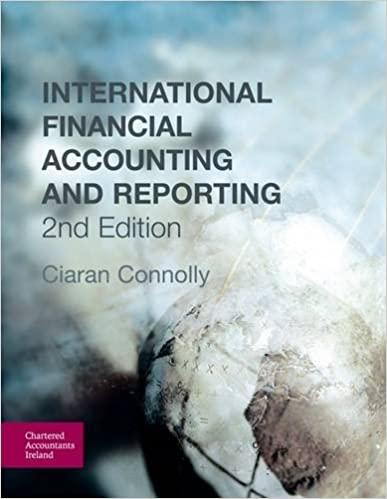Question
The following transactions were completed by Irvine Company during the current fiscal year ended December 31: Feb. 8 Received 40% of the $17,000 balance owed
The following transactions were completed by Irvine Company during the current fiscal year ended December 31: Feb. 8 Received 40% of the $17,000 balance owed by DeCoy Co., a bankrupt business, and wrote off the remainder as uncollectible. May 27 Reinstated the account of Seth Nelsen, which had been written off in the preceding year as uncollectible. Journalized the receipt of $7,405 cash in full payment of Seths account. Aug. 13 Wrote off the $6,460 balance owed by Kat Tracks Co., which has no assets. Oct. 31 Reinstated the account of Crawford Co., which had been written off in the preceding year as uncollectible. Journalized the receipt of $3,940 cash in full payment of the account. Dec. 31 Wrote off the following accounts as uncollectible (compound entry): Newbauer Co., $7,095; Bonneville Co., $5,540; Crow Distributors, $9,495; Fiber Optics, $1,035. Dec. 31 Based on an analysis of the $1,782,000 of accounts receivable, it was estimated that $35,640 will be uncollectible. Journalized the adjusting entry. 1. Record the January 1 credit balance of $25,615 in a T-account for Allowance for Doubtful Accounts. 2. A. Journalize the transactions. Refer to the Chart of Accounts for exact wording of account titles. B. Post each entry that affects the following selected T-accounts and determine the new balances: Allowance for Doubtful Accounts and Bad Debt Expense. 3. Determine the expected net realizable value of the accounts receivable as of December 31 (after all of the adjustments and the adjusting entry). 4. Assuming that instead of basing the provision for uncollectible accounts on an analysis of receivables, the adjusting entry on December 31 had been based on an estimated expense of of 1% of the net sales of $17,760,000 for the year, determine the following: A. Bad debt expense for the year. B. Balance in the allowance account after the adjustment of December 31. C. Expected net realizable value of the accounts receivable as of December 31. T-Accounts Shaded cells have feedback. 1. Record the January 1 credit balance of $25,615 in a T-account for Allowance for Doubtful Accounts. 2. B. Post each entry that affects the following selected T-accounts and determine the new balances: Allowance for Doubtful Accounts and Bad Debt Expense. Allowance for Doubtful Accounts Feb. 8 Correct 10,200 Jan. 1 Balance 25,615 Aug. 13 Correct 6,460 May 27 Correct 7,405 Dec. 31 Correct 23,165 Oct. 31 Correct 3,940 Dec. 31 Adjusting Entry Correct Dec. 31 Unadjusted Balance Correct Dec. 31 Adj. Balance Bad Debt Expense Dec. 31 Adjusting Entry Correct Points: 14 / 18 Feedback Check My Work 1. and 2.B. Set up T-accounts. Journal Shaded cells have feedback. 2. A. Journalize the transactions. Refer to the Chart of Accounts for exact wording of account titles. All transactions on this page must be entered (except for post ref(s)) before you will receive Check My Work feedback. PAGE 10 JOURNALACCOUNTING EQUATION Score: 6/249 DATE DESCRIPTION POST. REF. DEBIT CREDIT ASSETS LIABILITIES EQUITY 1 Cash 2 3 4 5 6 7 8 9 10 11 12 13 14 15 16 17 18 19 20 Points: 1.16 / 48 Feedback Check My Work 2.A. Recall that under the allowance method, the entry to write off an account debits Allowance for Doubtful Accounts and credits Accounts Receivable. In such cases where an account receivable that has been written off is later collected, the account is reinstated by an entry that reverses the write-off entry. Then record the receipt of cash as payment for the account. The amount of bad debt expense is affected by the balance in the allowance account.
Step by Step Solution
There are 3 Steps involved in it
Step: 1

Get Instant Access to Expert-Tailored Solutions
See step-by-step solutions with expert insights and AI powered tools for academic success
Step: 2

Step: 3

Ace Your Homework with AI
Get the answers you need in no time with our AI-driven, step-by-step assistance
Get Started


